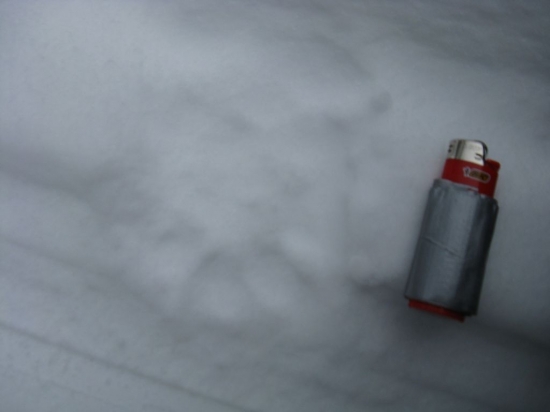An Unexpected Find
Lynx Tracksby Dan Hartman
April 1, 2013
Story by guest reporter Danielle Chalfant who grew up in Yellowstone and has worked as an interpretive ranger and with The Yellowstone Association."On February twenty-seventh I found lynx tracks. I was out on a ski, guiding a group of visitors with the Yellowstone Association, when I came upon the tracks. We glided through an older forest, a mix of old spruce and fir trees, open mature lodgepole, and some meadows with a meandering creek.
As we skied down the trail I noticed many tracks. We saw the letter “H” shaped impressions left by red squirrels darting to and from trees. We observed tracks left by an American marten who wove its way through the forest in constant investigation. We enjoyed seeing the tiny tracks of mice as they had apparently scurried haphazardly across the snow. Snowshoe hare tracks were also abundant along our route. Coyote tracks appeared here and there in their typical wandering fashion. The coyote tracks sank nearly a foot deep in the soft snow this particular day. Despite the fact they usually only weigh between 25 and 45 pounds, they still sunk in. I noted this as I skied along.
While these facts and observations may seem unrelated, they have everything to do with why I found lynx tracks. I am by no means an expert tracker. I know some patterns and signs and I have seen many tracks, but I am not an expert. Finding these tracks was about powers of observation and deduction rather than expertise alone. It was about knowing the place and using clues that were scattered along the trail that day. If I had not noticed the coyote tracks, I would never have “seen” the lynx tracks for what they were.
Further down the trail I crossed a set of wide tracks that seemed to “float” across the snow. This was the first clue that set these tracks apart in my mind. I paused with my group to study them more closely. I first examined the best track, which had been placed across the well-packed ski trail. The rest of the track set were in deep snow on either side of the trail. We were the first group to ski this trail today, so we were able to see the vague pattern of the foot with its pad and four toes.
This trail is skied on a daily basis most of the winter so I knew this track was very fresh. Four toes and pad meant I could narrow down the species on my list of who left this track. It meant this animal was in the dog or cat family, as each have four visible toes. Weasel family members (wolverine, otter, weasel, badger) have five toes and one pad. Dogs usually show their claws, but claws would have been undetectable in these snow conditions. Dogs have a more rectangular track (longer than they are wide) than cats.
This track seemed to be very round. Still, to help rule out the dogs, I had just seen coyote tracks the same day in the same snow conditions and these looked very different. These tracks were much larger than a coyote and didn't sink into the snow nearly as far. I ruled out fox tracks because they are even smaller than coyotes. These tracks floated too much to have belonged a wolf. Wolves usually weigh between 75 and 150 pounds in Yellowstone. I believed this track belonged to a cat.
Bobcats have feet about the same size as coyotes, so they too are ruled out. So now I had narrowed it down to lynx or mountain lion. These two cats have tracks that can overlap in size. I have seen many lion tracks in the past, even in snow, and these didn't seem quite right. These tracks belonged to a cat with a short stride. Lions have a very long body, which gives them a long stride. Lions usually weigh between 75 and 275 pounds, whereas lynx weigh an average of about 20 pounds.
I was convinced these tracks were those of a lynx because of their size, shape, stride and depth in the snow. I didn't know for sure, but I felt strongly they were. The fact that we saw snowshoe hare tracks also made finding lynx tracks more plausible. I knew still, that even though the signs seemed to add up to a lynx, a lynx track was very rare and the odds were not in my favor.
That night I consulted various friends and our renowned local tracker Dr. Jim Halfpenny to see if he could investigate the tracks and back up my observation. Halfpenny was able to go out the next day and find the tracks, ultimately confirming my belief that I had discovered lynx tracks. Canadian lynx are a threatened species as listed under the Endangered Species Act. They are rare in our ecosystem, but do exist here.
Consistently deep snow and a healthy snowshoe hare population are vital to lynx survival. I feel very humbled to have experienced lynx tracks in my own backyard. Sharing this place with such a wild and elusive animal is enthralling. It's moments like this that instill our feeling of wildness. You never know what you'll find out there. It takes a good observer, not solely an expert, to see amazing things. Keep learning from what is around you and absorb as much as you can about your surroundings. Perhaps you will find yourself looking for subtle clues to an exciting new mystery you have yet to discover.
For help referencing place names, use the Yellowstone SpotR app:
• Download Yellowstone SpotR for Apple iOS
• Download Yellowstone SpotR for Google Android



